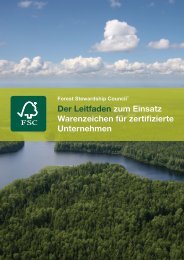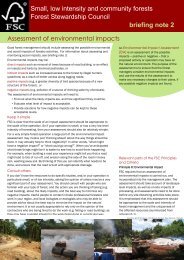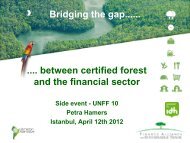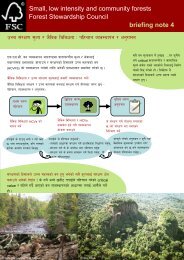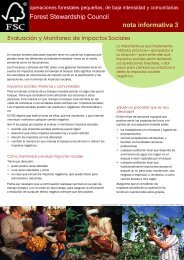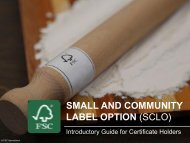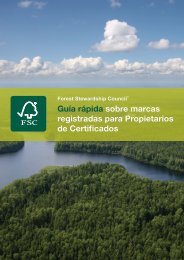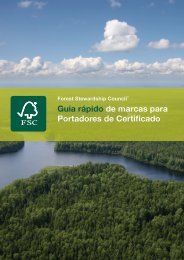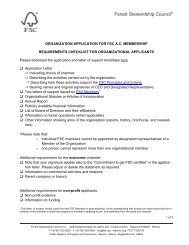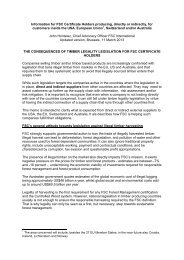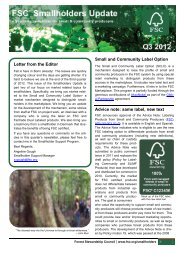FSC Guide to integrated pest, disease and weed management in ...
FSC Guide to integrated pest, disease and weed management in ...
FSC Guide to integrated pest, disease and weed management in ...
- No tags were found...
Create successful ePaper yourself
Turn your PDF publications into a flip-book with our unique Google optimized e-Paper software.
IPM <strong>Guide</strong>ment of any strategy <strong>to</strong> combat the damag<strong>in</strong>g effects of future climate change. A blanket prohibitionon the use of certa<strong>in</strong> non <strong>in</strong>digenous plant <strong>and</strong> animal species will not always be thecorrect response <strong>in</strong> all situations.The challenge for managers is <strong>to</strong> respond <strong>to</strong> likely threats from potentially damag<strong>in</strong>g or <strong>in</strong>vasivespecies <strong>in</strong> the context of their own particular region, <strong>and</strong> a risk assessment should bemade at a country or regional basis before any new potentially <strong>in</strong>vasive species are <strong>in</strong>troduced.Even if judged <strong>to</strong> be safe, after any <strong>in</strong>troduction, the new species should be carefullymoni<strong>to</strong>red <strong>to</strong> ensure it does not subsequently become <strong>in</strong>vasive, <strong>to</strong> help determ<strong>in</strong>e if any remedialaction needs <strong>to</strong> be taken, for example <strong>to</strong> prevent wild<strong>in</strong>gs from plantation species <strong>in</strong>vad<strong>in</strong>g<strong>in</strong>digenous forests. In addition, both <strong>in</strong>ternational <strong>and</strong> country level legislation is <strong>in</strong>place <strong>to</strong> regulate the <strong>in</strong>ternational movement of organisms pos<strong>in</strong>g phy<strong>to</strong>sanitary risks or ecosystemthreats, <strong>and</strong> regardless of forest estate certification requirements, these regulations<strong>and</strong> agreements must be complied with by forest managers. Further guidance on generalpr<strong>in</strong>ciples for moni<strong>to</strong>r<strong>in</strong>g <strong>and</strong> respond<strong>in</strong>g <strong>to</strong> the threats posed by alien <strong>in</strong>vasive species can befound at the <strong>FSC</strong> website http://www.fsc.org/<strong>in</strong>ternationalpolicies.html, brochures > IPM <strong>Guide</strong>> Invasive Species Support<strong>in</strong>g Document <strong>to</strong> <strong>FSC</strong> IPM <strong>Guide</strong>.4. Responses <strong>to</strong> a <strong>pest</strong>, <strong>weed</strong> or <strong>disease</strong> problemFigure 1 outl<strong>in</strong>es the core decision key that can be applied <strong>to</strong> help determ<strong>in</strong>e the most appropriatemethod of respond<strong>in</strong>g <strong>to</strong> any <strong>pest</strong>, <strong>disease</strong> <strong>and</strong> <strong>weed</strong> problems <strong>in</strong> <strong>FSC</strong> certified forests,<strong>in</strong>clud<strong>in</strong>g <strong>in</strong>digenous forests <strong>and</strong> plantations.The most appropriate response, which may often be <strong>to</strong> take no action, should be the one thatreduces negative impacts on the forest <strong>and</strong> wider environment below acceptable thresholds,<strong>and</strong> that m<strong>in</strong>imises impacts on human health <strong>and</strong> <strong>in</strong>digenous peoples. Impacts may arise bothfrom the <strong>pest</strong>, <strong>disease</strong> or <strong>weed</strong> itself, as well as from any control measures that might beadopted <strong>to</strong> manage the problem.It would be impossible <strong>to</strong> provide detailed guidance on the optimal <strong>management</strong> of all <strong>pest</strong>s,<strong>disease</strong>s <strong>and</strong> <strong>weed</strong> problems likely <strong>to</strong> affect certified forests throughout the world. Thereforethe decision key does not attempt <strong>to</strong> provide a def<strong>in</strong>itive <strong>and</strong> prescriptive approach <strong>to</strong> IntegratedPest <strong>and</strong> Disease Management. Rather, the core decision key is a generic framework,a <strong>to</strong>ol that can be applied us<strong>in</strong>g regional expertise <strong>and</strong> experience <strong>to</strong> develop more susta<strong>in</strong>able<strong>management</strong> approaches <strong>to</strong> deal<strong>in</strong>g with <strong>pest</strong>, <strong>weed</strong> <strong>and</strong> <strong>disease</strong> problems.Note that <strong>in</strong> us<strong>in</strong>g the framework, when deal<strong>in</strong>g with familiar problems <strong>and</strong> situations, it maynot always prove necessary <strong>to</strong> operate every step of the process <strong>in</strong> detail <strong>and</strong> complete a recordform for every <strong>in</strong>dividual operational site. For example, it may <strong>in</strong>stead be sufficient <strong>to</strong> usethe framework at the commencement of a proposed annual control programme <strong>to</strong> determ<strong>in</strong>ethe best approach for a group of very similar sites fac<strong>in</strong>g the same <strong>pest</strong> problem. The conclu-9 of 19



